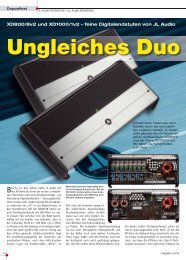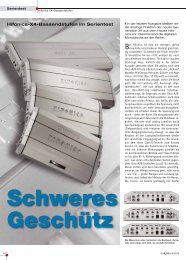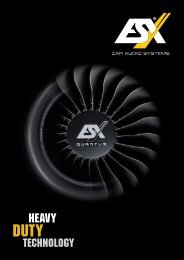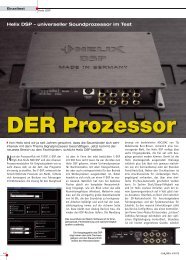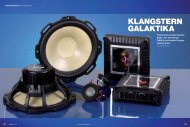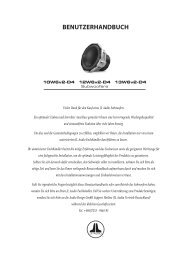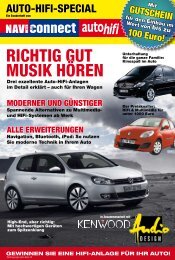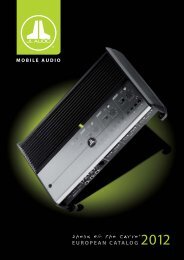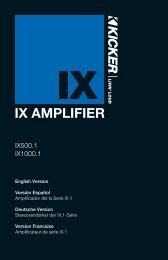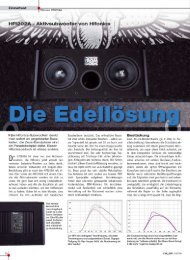SVC - S - Audio Design GmbH
SVC - S - Audio Design GmbH
SVC - S - Audio Design GmbH
You also want an ePaper? Increase the reach of your titles
YUMPU automatically turns print PDFs into web optimized ePapers that Google loves.
LIMITED WARRANTY STATEMENT<br />
Rockford Corporation offers a limited warranty on Rockford Fosgate products on the following terms:<br />
Length of Warranty<br />
Speakers – 1 Year. Any Factory Refurbished Product – 90 days (receipt required)<br />
What is Covered<br />
This warranty applies only to Rockford Fosgate products sold to consumers by Authorized Rockford Fosgate<br />
Dealers in the United States of America or its possessions. Product purchased by consumers from an<br />
Authorized Rockford Fosgate Dealer in another country are covered only by that country’s Distributor and<br />
not by Rockford Corporation.<br />
Who is Covered<br />
This warranty covers only the original purchaser of Rockford product purchased from an Authorized<br />
Rockford Fosgate Dealer in the United States. In order to receive service, the purchaser must provide<br />
Rockford with a copy of the receipt stating the customer name, dealer name, product purchased and date of<br />
purchase. Products found to be defective during the warranty period will be repaired or replaced<br />
(with a product deemed to be equivalent) at Rockford's discretion.<br />
What is Not Covered<br />
1. Damage caused by accident, abuse, improper operations, water, theft, shipping<br />
2.Any cost or expense related to the removal or reinstallation of product<br />
3. Service performed by anyone other than Rockford or an Authorized Rockford Fosgate Service Center<br />
4.Any product which has had the serial number defaced, altered, or removed<br />
5. Subsequent damage to other components<br />
6.Any product purchased outside the U.S.<br />
7.Any product not purchased from an Authorized Rockford Fosgate Dealer<br />
Limit on Implied Warranties<br />
Any implied warranties including warranties of fitness for use and merchantability are limited in duration to the<br />
period of the express warranty set forth above. Some states do not allow limitations on the length of an implied<br />
warranty, so this limitation may not apply. No person is authorized to assume for Rockford Fosgate any other<br />
liability in connection with the sale of the product.<br />
How to Obtain Service<br />
Contact the Authorized Rockford Fosgate Dealer you purchased this product from. If you need further<br />
assistance, call 1-800-669-9899 for Rockford Customer Service.You must obtain an RA# (Return<br />
Authorization number) to return any product to Rockford Fosgate.You are responsible for shipment<br />
of product to Rockford.<br />
EU Warranty<br />
This product meets the current EU warranty requirements, see your Authorized dealer for details.<br />
Check our website for additional information and<br />
updates on these products.<br />
www.RockfordFosgate.com<br />
2008 Rockford Corporation.All rights reserved.<br />
Rockford Fosgate and the Rockford Fosgate logo are either<br />
registered trademarks or trademarks of Rockford Corporation.<br />
06/08 B.M.<br />
1230-55016-02 Printed in China<br />
MARINE GRADE<br />
M2-<strong>SVC</strong> - SINGLE VOICE COIL SUBWOOFERS<br />
10" 12"<br />
4-Ohm M210S4 M212S4<br />
Installation & Operation<br />
Serial Number: Date of Purchase:
SAFETY<br />
CAUTION: Before installation, disconnect the battery<br />
negative (-) terminal to prevent damage<br />
to the unit, fire and/or possible injury.<br />
This manual outlines three specific types of enclosures that provide<br />
distinctly different performance.This section is to help you decide<br />
which type is best for your application.<br />
SEALED ENCLOSURES<br />
RECOMMENDED ENCLOSURES<br />
Sealed enclosures are the simplest to build.The most important part of<br />
building a sealed enclosure is to make sure that the enclosure is airtight.<br />
Using glue and some type of sealant on all seams will ensure solid<br />
construction and prevent air leaks.The box volume will directly impact the<br />
performance of the speaker. Larger enclosures will provide flatter<br />
response and deeper bass where smaller boxes will provide a bump in the<br />
response curve and generally higher output for greater SPL.<br />
Advantages of sealed enclosures:<br />
• Small enclosures<br />
• Linear (Flat) response<br />
• No port noise<br />
• High power handling at all frequencies<br />
• Excellent for sound quality<br />
• Extended low frequency output when compared to vented enclosures<br />
PRACTICE SAFE SOUND<br />
Continuous exposure to sound pressure levels over 100dB may<br />
cause permanent hearing loss. High powered auto sound systems<br />
may produce sound pressure levels well over 130dB. Use common<br />
sense and practice safe sound.<br />
BUILDING AN ENCLOSURE<br />
To work properly, the walls of the enclosure must be rigid and not flex<br />
when subjected to the high pressures generated by the speaker's<br />
operation. For optimum performance, we recommend using 3/4" MDF<br />
(Medium Density Fiberboard) and internal bracing.The enclosure should<br />
be glued together and secured with nails or screws.<br />
CALCULATING VOLUME<br />
CARTON CONTENTS<br />
• (1) Marine Grade M2 Series Subwoofer<br />
• (1) Decorative trim ring<br />
• (8) Socket head stainless screws<br />
• (1) Socket head driver bit<br />
Calculating volume is merely a matter of measuring the dimensions in<br />
inches and using the formula: H x W x D divided by 1728 (cubic feet). See<br />
block below.<br />
Box Volume Height" x Width" x Depth"<br />
Divided by (cubic feet) 1728<br />
VENTED ENCLOSURES<br />
Vented enclosures vary only from the sealed enclosure in that a vent or<br />
port is added to “tune” the enclosure.The enclosures recommended are<br />
designed for great overall performance. Larger boxes tend to be easy to<br />
tune to lower frequencies while medium and small boxes are easier to<br />
tune to higher frequencies.The vented design is less linear in response<br />
than the sealed box but with noticeably more output at the tuning frequency.<br />
Advantages of vented enclosures:<br />
• Higher average output than sealed<br />
• Tuning frequency can be easily adjusted by changing port length<br />
• Deep bass response with lower power requirements<br />
• Great for high output with limited power<br />
INFINITE BAFFLE DESIGN<br />
These designs typically called “IB”, are the easiest enclosure<br />
types to build. The reason is that you are not actually building<br />
an enclosure, but rather simulating one.This is done by<br />
closing off a cavity area (ie; car trunk, enclosed area of a<br />
boat hull) with a baffle board.This creates your “IB” subwoofer<br />
system. Essentially, an “IB” design can just be considered<br />
a large sealed enclosure design. Given that an “IB”<br />
design does not rely on a volume of air for its suspension,<br />
the low frequency output is driven by the speaker's inherent<br />
damping or “Qtc”.<br />
Advantages of infinite baffle design:<br />
• Easy to build<br />
• Light-weight<br />
• Deep bass response with lower power requirements<br />
If two facing sides are of uneven length, add them together and divide by<br />
two to take the average. Using this number will give you the volume<br />
without the necessity of calculating the box in sections and adding the<br />
sections together.The thickness of the baffle material reduces the internal<br />
volume so this must be subtracted from the outside dimensions to<br />
determine the internal volume.The speaker itself also reduces the<br />
internal volume.The amount of air displaced by each model is listed on<br />
the specification sheet and should also be subtracted from the gross<br />
volume calculation.<br />
The graph shown here is a sample of how SPL and Excursion<br />
differs between the various enclosures.<br />
SPL & Excursion (@100 Watts) - Impedance (@1 Watt)<br />
2
NOTE:<br />
NOTE:<br />
SEALED ENCLOSURES<br />
Vb is the gross volume, which is the TOTAL internal volume, before any speaker and/or port displacement.<br />
All external dimensions were based on the use of 3/4" (1.90cm) materials.<br />
When using enclosures other than recommended, call Technical Support for correct application.<br />
Optimum Sealed Enclosure Recommendation<br />
Position to<br />
Align Holes<br />
W<br />
SEALED ENCLOSURES 10" 12"<br />
M210S4<br />
M212S4<br />
V b - Internal Area cu. ft. (Liter) 0.75 (21.24) 1.00 (28.33)<br />
F b - Tuning Frequency (Hz 60.3 53.5<br />
F 3 - -3dB Point (Hz) 60.6 53.7<br />
Qtc- Enclosure Damping 0.77 0.82<br />
H<br />
H - Height-inch (cm) 14.5 (36.83) 15.5 (39.37)<br />
W - Width-inch (cm) 17.5 (44.45) 17.625 (44.77)<br />
D - Depth-inch (cm) 8.5 (21.59) 12.0 (30.48)<br />
D<br />
Recommended Sealed Enclosure Volume Range<br />
SEALED ENCLOSURES 10" 12"<br />
M210S4<br />
M212S4<br />
V b - Volume Range cu. ft. 0.50 to 0.85 0.70 to 1.80<br />
(Liter) (14.16 to 24.07) (19.82 to 50.97)<br />
NOTE:<br />
NOTE:<br />
Specifications subject to change without notice<br />
VENTED ENCLOSURES<br />
Vb is the gross volume, which is the TOTAL internal volume, before any speaker and/or port displacement.<br />
All external dimensions were based on the use of 3/4" (1.90cm) materials.<br />
When using enclosures other than recommended, call Technical Support for correct application.<br />
Optimum Vented (Ported) Enclosure Sizes<br />
Position to<br />
Align Holes<br />
W<br />
VENTED ENCLOSURES 10" 12"<br />
M210S4<br />
M212S4<br />
V b - Internal Area cu. ft. (Liter) 1.25 (35.40) 1.50 (42.50)<br />
F b - Tuning Frequency (Hz 48.6 40.0<br />
F 3 - -3dB Point (Hz) 40.0 37.2<br />
H - Height-inch (cm) 14.5 (36.83) 15.5 (39.37)<br />
H<br />
W - Width-inch (cm) 22.5 (57.15) 20.25 (51.44)<br />
D - Depth-inch (cm) 10.0 (25.40) 12.5 (31.75)<br />
P - Port Diameter and<br />
Length-inch (1) 4 x 8.52 (1) 3 x 5.74<br />
(cm) (1) (10.16 x 21.65) (1) (7.62 x 14.59)<br />
P<br />
D<br />
Number of ports noted in ( )<br />
Specifications subject to change without notice<br />
NOTE:<br />
INFINITE BAFFLE<br />
An IB enclosure design represents an application where the<br />
compliance of the air volume within the enclosure is greater<br />
than the compliance on the speaker’s suspension (Vas). An<br />
infrasonic filter is required for reliable performance.<br />
Infinite Baffle 10" 12"<br />
M210S4<br />
M212S4<br />
F b - Tuning Frequency (Hz 57.5 50.1<br />
F 3 - -3dB Point (Hz) 58.0 50.5<br />
Vas - cu. ft. (Liter) 2.02 (50.80) 4.43 (63.50)<br />
Qtc- Enclosure Damping 0.63 0.58<br />
IMPORTANT:<br />
3<br />
Take care when installing your baffle board. Air leaks<br />
can cause significant performance loss.The more care<br />
you take to ensure the cavity area and baffle board are<br />
sealed will yield optimum results.
PHYSICAL DIMENSIONS<br />
MARINE GRADE M2-<strong>SVC</strong> 10" 12"<br />
M210S4 M212S4<br />
A - Trim Ring Diameter-inch 11.54 13.58<br />
(cm) (29.30) (34.50)<br />
B - Trim Ring Height-inch 1.31 1.65<br />
(cm) (3.33) (4.19)<br />
C - Mounting Diameter-inch 9.0 10.95<br />
(cm) (22.82) (27.82)<br />
D - Mounting Depth-inch 5.54 6.58<br />
(cm) (14.07) (16.72)<br />
E - Overall Diameter-inch 10.39 12.44<br />
(cm) (26.40) (31.60)<br />
F - Screw Hole Diameter-inch 9.84 11.81<br />
(cm) (25.00) (30.00)<br />
G - Speaker Displacement - cu. ft. 0.154 0.258<br />
(Liter) (4.35) (7.30)<br />
M - Mass (Weight) - lbs. 12.3 18.3<br />
(kg) (5.6) (8.3)<br />
Specifications subject to change without notice<br />
SPECIFICATIONS<br />
MARINE GRADE M2-<strong>SVC</strong> 10" 12"<br />
M210S4 M212S4<br />
Nominal Impedance (ohms) 4 4<br />
Frequency Response (Hz) 40-250 30-250<br />
Voice Coil Diameter - inch 1.95 (4-Layer) 1.95 (6-Layer)<br />
(cm) (4.95) (4.95<br />
Displacement - cu. ft. 0.154 0.258<br />
(Liter) (4.35) (7.3)<br />
Fs - Free Air Resonance (Hz) 45 35<br />
Qts 0.57 0.52<br />
Vas - cu. ft. 0.71 1.56<br />
(Liter) (20.2) (44.3)<br />
Xmax - inch 0.393 0.472<br />
(cm) (1.00) (1.20)<br />
SPL (dB @ 1w/1m) 86.0 87.0<br />
Power Handling-Watts (RMS) 250 300<br />
(Peak) 500 600<br />
Specifications subject to change without notice<br />
A<br />
B<br />
D<br />
C<br />
G<br />
F<br />
E<br />
4
WIRING CONFIGURATIONS<br />
Parallel Wiring<br />
By varying the wiring configuration of your speakers you can create an<br />
impedance load to match your system.Altering the wiring configurations<br />
gives a range of options for impedance loads. Series, Parallel, or<br />
Series-Parallel wiring configurations are different techniques for wiring<br />
speakers that provide different loads. Series configuration is a string<br />
method where speakers are wired end to end. Parallel configuration<br />
uses two or more speakers wired across common terminals.<br />
Series-Parallel configuration combines both techniques. Choose the<br />
wiring diagram that corresponds to the number of woofers and the<br />
impedance of your amplifier.<br />
(2) 4 ohm <strong>SVC</strong> Speaker = 2 ohm Load<br />
SUBWOOFER CROSSOVERS<br />
Series/Parallel Wiring<br />
There are two operational types of crossovers, passive and active.<br />
Passive crossovers (coils or inductors) are placed on the speaker leads<br />
between the amplifier and speaker.An active crossover is an electronic<br />
filter that separates the audio signal fed to different amplifiers. For<br />
optimum subwoofer performance, we recommend using an active<br />
80-100Hz low-pass crossover at 12dB/octave.<br />
(4) 4 ohm <strong>SVC</strong> Speaker = 4 ohm Load<br />
GRILLE REMOVAL<br />
NOTE: This should be done prior to mounting the trim ring over the speaker, since<br />
the mounting screws will also hold the grille onto the trim ring.<br />
1. Remove the four (4) screws holding the grille to the trim ring and pull away.<br />
2. Reinstall the screws into the trim ring or keep in a safe place in case you wish to<br />
reattach the grille.<br />
A. Push to insert the wire.<br />
Français<br />
A. Poussez pour insérer le fil.<br />
Español<br />
A. Empuje para insertar el alambre.<br />
Deutsch<br />
A. Drücken Sie, um Kabel einzusetzen.<br />
5
Français<br />
MISE EN GARDE : avant d'entamer l'installation, déconnectez la broche<br />
négative (-) de la batterie pour éviter tout risque de blessures, d’incendie ou<br />
de dommages à l'appareil.<br />
PRATIQUEZ UNE ÉCOUTE SANS RISQUES MD<br />
Une exposition continue à des niveaux de pression acoustique supérieurs<br />
à 100 dB peut causer une perte d'acuité auditive permanente. Les<br />
systèmes audio de forte puissance pour auto peuvent produire des<br />
niveaux de pression acoustique bien au-delà de 130 dB. Faites preuve de<br />
bon sens et pratiquez une écoute sans risques<br />
Enceintes recommandées<br />
Ce manuel présente trois types d'enceinte particuliers offrant des performances nettement<br />
différentes. Cette section vous aidera à déterminer quel type convient le mieux à<br />
votre utilisation.<br />
Enceintes Étanches<br />
Les enceintes étanches sont les plus faciles à fabriquer. À cet égard, la chose la plus<br />
importante dans leur fabrication est de vous assurer qu'elles sont vraiment<br />
hermétiques.Appliquez de la colle et un produit d'étanchéité sur tous les joints pour<br />
solidifier l'ensemble et empêcher toute fuite d'air. Le volume du caisson influe directement<br />
sur la performance du haut-parleur. Les enceintes de plus grande dimension<br />
délivrent une réponse uniforme en fréquence avec des graves profonds alors que les<br />
enceintes plus petites ont une courbe de réponse plus prononcée et un rendement<br />
généralement supérieur pour un niveau de pression acoustique plus élevé.<br />
Avantage des enceintes étanches :<br />
• Petites enceintes<br />
• Réponse linéaire (uniforme)<br />
• Pas de bruit d'évent<br />
• Puissance élevée sur toutes les fréquences<br />
• Excellentes en ce qui concerne la qualité du son<br />
Enceintes À Évent<br />
Les enceintes à évent se distinguent des enceintes étanches du fait qu'on y ajoute un<br />
évent ou port pour les « accorder ». Les enceintes recommandées sont conçues pour<br />
offrir d'excellentes performances. Il est généralement plus facile d'accorder les caissons<br />
plus grands pour l'obtention de basses fréquences et les caissons moyens et petits pour<br />
des fréquences plus élevées. Les enceintes à évent ont une réponse moins linéaire que<br />
les enceintes étanches mais dégagent nettement plus de puissance à la fréquence d'accord.<br />
Avantages des enceintes à évent :<br />
• Rendement moyen supérieur par rapport aux modèles étanches<br />
• La fréquence d'accord peut être facilement réglée en changeant la longueur<br />
de l'évent<br />
• Reproduction profonde des basses avec une puissance d'entrée moindre<br />
• Excellent choix pour un rendement élevé à faible puissance d'entrée<br />
Montage en Baffle Infini<br />
Les enceintes à baffle infini sont les plus faciles à construire. En effet, il ne s'agit pas<br />
vraiment de fabriquer une enceinte, mais plutôt d'en simuler une. Cela s'effectue en<br />
fermant une cavité (comme un coffre de voiture ou une partie de coque de bateau) avec<br />
une cloison, appelée écran acoustique. Cela crée un caisson de grave en baffle infini. En<br />
fait, le montage en baffle infini peut être considéré comme une grande enceinte close. Un<br />
montage en baffle infini ne dépendant pas d'un volume d'air pour la suspension, la<br />
réponse dans le grave est assurée par l'amortissement intrinsèque du haut-parleur ou<br />
Qtc.<br />
Avantages du montage en baffle infini :<br />
• Facile à construire<br />
• Faible poids<br />
• Réponse profonde dans le grave à une puissance relativement faible.<br />
Construire Un Caisson<br />
Pour fonctionner convenablement les parois du caisson doivent être rigides lorsqu'elles<br />
sont soumises aux hautes pressions dues au fonctionnement du haut-parleur. Nous vous<br />
recommandons d'utiliser des panneaux de bois aggloméré à haute ou moyenne densité<br />
de particules de type “MDF”. Ces panneaux sont disponibles dans la plupart des magasins<br />
de bricolage. Pour un caisson de grand volume il est recommandé de placer des<br />
renforts à l'intérieur du caisson. Les différents côtés devront être collés (colle à bois) et<br />
vissés (ou éventuellement cloués). Il est recommandé de mettre un joint de silicone dans<br />
les arêtes internes du caisson afin d'éviter les fuites d'air.<br />
Calcu du Volume<br />
On calcule le volume en mesurant la dimension de chaque côté et en utilisant la<br />
formule suivante:<br />
Volume du caisson Hauteur (cm) x Longueur (cm) x Largeur (cm)<br />
Divisé près (Litres) 1000<br />
Si les due côtés qui se font face n'ont pas la même longueur, additionnez les et divisez le<br />
résultat par deux pour obtenir la moyenne des deux longueurs. Utilisez le nombre ainsi<br />
obtenu dans la formule pour déterminer le litrage. Cette méthode permet d'obtenir le<br />
6<br />
volume du caisson sans devoir faire de calculs compliqués de section de volume.<br />
L'épaisseur du matériau dont est fait le caisson réduit le volume interne de celui-ci.<br />
Lorsqu'on mesure les côtés du caisson il ne faut donc pas oublier d'oter des mesures<br />
l'epaisseur du matériau. Le haut-parleur lui-même diminue le volume interne du caisson.<br />
Le volume d'air déplacé par chaque modèle de haut-parleur est repris dans les<br />
spécifications techniques et doit également être soustrait du volume total.<br />
Configuration du câblage<br />
En variant la configuration du câblage de vos haut-parleurs, vous pouvez créer une<br />
charge d'impédance correspondant à votre système. La modification des configurations<br />
de câblage offre tout un choix d'options en ce qui concerne la charge d'impédance. Les<br />
câblages série, parallèle, ou série/parallèle sont des techniques permettant de câbler les<br />
haut-parleurs de manière à produire des charges différentes. La configuration série consiste<br />
à câbler les haut-parleurs à la chaîne, bout à bout. La configuration parallèle utilise<br />
deux ou plusieurs haut-parleurs branchés sur des bornes communes. La configuration<br />
série/parallèle combine les deux techniques. Choisissez le schéma ci-dessous qui correspond<br />
au nombre de haut-parleurs de graves et à l'impédance de votre ampli.<br />
Filtres de subwoofer<br />
On distingue deux types de filtres opérationnels : passif et actif. Les filtres passifs (bobines<br />
ou inducteurs) sont placés sur les fils de haut-parleur, entre l'ampli et le haut-parleur. Un<br />
filtre actif est un filtre électronique qui sépare le signal audio envoyé à différents amplis.<br />
Pour obtenir une performance optimale du subwoofer, nous recommandons l'utilisation<br />
d'un filtre actif passe-bas 80-100 Hz à 12 dB/octave.<br />
Retrait de la grille<br />
REMARQUE : Cette étape doit s'effectuer avant le montage de l'anneau<br />
de garniture sur le haut-parleur, car les vis de montage fixeront<br />
également la grille sur cet anneau.<br />
1. Retirez les quatre (4) vis retenant la grille sur l'anneau de garniture et détachez<br />
celle-ci.<br />
2. Réinstallez les vis sur l'anneau de garniture ou conservez-les en lieu sûr pour le cas<br />
où vous souhaiteriez remonter la grille.<br />
Español<br />
PRECAUCIÓN: Antes de la instalación, desconecte el terminal negativo<br />
de la batería (-) para prevenir daño a la unidad, incendio y/o posibles<br />
lesiones.<br />
PRACTIQUE EL SONIDO SEGURO<br />
El contacto continuo con niveles de presión de sonido superiores a 100 dB<br />
puede causar la pérdida permanente de la audición. Los sistemas de sonido para<br />
automóviles de alta potencia pueden producir niveles de presión de sonido<br />
superiores a los 130 dB. Use su sentido común y practique el sonido seguro.<br />
Cajas recomendadas<br />
Este manual describe tres tipos específicos de cajas que proporcionan un rendimiento<br />
marcadamente distinto. Esta sección le ayuda a decidir qué tipo es el mejor para su aplicación.<br />
Cajas Cerradas<br />
Las cajas cerradas son las más fáciles de hacer. La parte más importante de la<br />
construcción de una caja cerrada es garantizar su hermetismo. El uso de pegante y algún<br />
tipo de sellador en todos los bordes garantizará una construcción sólida y evitará fugas<br />
de aire. El volumen de la caja impacta directamente el rendimiento del altavoz. Las cajas<br />
más grandes ofrecen una respuesta más plana y un bajo más profundo, mientras que las<br />
más pequeñas ofrecen un incremento en la curva de respuesta y generalmente una<br />
salida mayor, para un mayor NPS.<br />
Ventajas de las cajas cerradas:<br />
• Cajas pequeñas<br />
• Respuesta lineal (plana)<br />
• No hay ruido del orificio<br />
• Capacidad de alta potencia en todas las frecuencias<br />
• Excelentes para la calidad del sonido<br />
Cajas con Orificios<br />
Las cajas con orificios sólo se diferencian de las cerradas en que se les hace un orificio<br />
para "sintonizarlas." Las cajas recomendadas son diseñadas para un gran rendimiento<br />
general. Las cajas grandes tienden a ser fáciles de sintonizar en las frecuencias graves,<br />
mientras que medianas y pequeñas son más fáciles de sintonizar en las frecuencias más<br />
altas. El diseño con orificios es de una respuesta menos lineal que el de la caja cerrada,<br />
pero tiene una salida notablemente mayor en la frecuencia de sintonización.<br />
Ventajas de las cajas con orificios:<br />
• Un promedio de salida mayor que las cerradas<br />
• La frecuencia de sintonización se ajusta fácilmente al cambiar la longitud del orificio<br />
• Respuesta de bajo profundo con menos exigencia de potencia<br />
• Fabulosas para salida alta con potencia limitada<br />
Diseño de Pantalla Acústica Infinita<br />
A estos diseños normalmente se les llama “IB”, son los tipos de caja más fáciles de construir.<br />
El motivo es que usted en realidad no está construyendo una caja, simplemente
simulando una. Esto se hace cerrando el área de la cavidad (por ejemplo, cajuela del<br />
automóvil, área cerrada del casco de una embarcación) con una tabla de pantalla acústica.<br />
Esto crea su sistema de subwoofer “IB”. Esencialmente, el diseño “IB” se puede considerar<br />
un diseño de caja grande sellada. Dado que le diseño “IB” no depende del volumen<br />
de aire para su suspensión, la salida de bajas frecuencias está impulsada por la amortiguación<br />
inherente del altavoz o “Qtc”.<br />
Ventajas del diseño de la pantalla acústica infinita:<br />
• Fácil de construir<br />
• Peso liviano<br />
• Respuesta grave de bajos con menores requisitos de potencia<br />
Construcción de una caja<br />
Para un buen funcionamiento las paredes de la caja deben ser rigidas y no se deben<br />
doblar cuando sean sometidas a la gran presión que ejerce el funcionamiento del altavoz.<br />
Recomendamos usar madera comprimida de mediana densidad, de 1.9 cm o fibra de<br />
media densidad. Si la caja es muy grande es necessario reforzarla internamente. Las<br />
juntas deben ser encoladas y aseguradas con tornillos o grapas. Internamente los bordes<br />
deben ser sellados con silicona para prevenir las fugas de aire. La cola para madera es la<br />
mejor opción.<br />
Cálculo de Volúmenes<br />
Para calcular el volumen sólo se han de medir las dimensiones en centímetros y aplicar<br />
la fórmula:<br />
Volumen du la caja Alto(cm) x Ancho(cm) x Profundidad(cm)<br />
Dividido por (en litros) 1000<br />
Si dos caras opuestas son de diferente tamaño, súmelas y divida el total por dos para<br />
obtener el promedio. Usando esta técnica se ahorrara el cálculo por secciones. El<br />
espesor del material con que está construida la caja reduce el volumen interno, de<br />
manera que ha de restarse de las dimensiones exteriores para determinar el volumen<br />
interior. La cantidad de aire que ocupa cada modelo viene especificado en la hoja de<br />
características y también debe sustraerse para obtener el volumen neto interior.<br />
Configuraciones del cableado<br />
Al variar la configuración del cableado de los altavoces, usted puede crear una impedancia<br />
de carga que iguale a su sistema. La alteración de la configuración de los cables da una<br />
gama de opciones para impedancia de carga. Las configuraciones en serie, paralela o en<br />
serie-paralela son técnicas diferentes para el cableado de los altavoces que ofrecen<br />
cargas diferentes. La configuración en serie es un método en cadena en el que los altavoces<br />
se conectan de punta a punta. La configuración paralela usa dos o más altavoces<br />
conectados a lo largo de terminales en común. La configuración en serie-paralela combina<br />
ambas técnicas. Escoja el diagrama que corresponda al número de altavoces para<br />
sonidos graves y la impedancia de su amplificador<br />
Filtros de Transición del altavoz para sonidos graves (Subwoofer<br />
X-Over)<br />
Hay dos tipos funcionales de filtros de transición, pasivos y activos. Los pasivos (bobinas<br />
o inductores) se conectan a los cables del altavoz, entre el amplificador y el altavoz. Un<br />
filtro de transición activo es un filtro electrónico que separa la señal de audio alimentada<br />
a diferentes amplificadores. Para un rendimiento óptimo del altavoz para sonidos graves,<br />
recomendamos el uso de un filtro de transición activo de 80-100Hz, paso bajo a<br />
12dB/octava.<br />
Retrait de la grille<br />
REMARQUE : Cette étape doit s'effectuer avant le montage de l'anneau<br />
de garniture sur le haut-parleur, car les vis de montage fixeront<br />
également la grille sur cet anneau.<br />
1. Retirez les quatre (4) vis retenant la grille sur l'anneau de garniture et détachez<br />
celle-ci.<br />
2. Réinstallez les vis sur l'anneau de garniture ou conservez-les en lieu sûr pour le cas<br />
où vous souhaiteriez remonter la grille.<br />
Deutsch<br />
VORSICHT: Entfernen Sie vor dem Einbau den negative Batteriepol,um<br />
Schäden am Gerät,Feuer bzw.mögliche Verletzungen zu vermeiden.<br />
PRAKTIZIEREN SIE SICHEREN SOUND<br />
Fortgesetzte Geräuschdruckpegel von über 100 dB können beim Menschen zu<br />
permanentem Hörverlust führen. Leistungsstarke Autosoundsysteme können<br />
Geräuschdruckpegel erzeugen, die weit über 130 dB liegen. Bitte wenden Sie<br />
gesunden Menschenverstand an und praktizieren Sie sicheren Sound.<br />
Empfohlene Gehäuse<br />
Diese Anleitung beschreibt drei spezifische Gehäusetypen,die deutlich unterschliedliche<br />
Performance erbringen.Dieser Abschnitt soll Ihnen bei der Entscheidung helfen,welcher Typ<br />
sich für Ihre Anwendung am besten eignet.<br />
Geschlossene Gehäuse<br />
Geschlossene Gehäuse lassen sich am leichtesten bauen.Der wichtigste Aspekt beim Bau<br />
eines geschlossenen Gehäuses ist zu gewährleisten,dass es luftdicht ist.Die Verwendung von<br />
Klebstoff und anderen Dichtungsmitteln an allen Fugen gewährleistet eine solide Konstruktion<br />
und verhindert Luftverlust.Das Gehäusevolumen wirkt sich unmittelbar auf die Performance<br />
des Lautsprechers aus.Größere Gehäuse bieten eine flachere Reaktion und tiefere Bässe,<br />
wohingegen kleinere Gehäuse eine Abweichung in der Reaktionskurve bieten und im<br />
Allgemeinen durch höhere Leistung zu einem höheren Schalldruckpegel führen.<br />
Vorteile von geschlossenen Gehäusen:<br />
• Kleine Gehäuse<br />
• Lineare (flache) Reaktion<br />
• Keine Öffnungsgeräusche<br />
• Hohe Nennbelastbarkeit in allen Frequenzbereichen<br />
• Ausgezeichnete Klangqualität<br />
Belüftete Gehäuse<br />
Belüftete Gehäuse unterscheiden sich von geschlossenen Gehäusen nur in sofern,als dass ein<br />
Luftschlitz bzw.eine Öffnung hinzugefügt wird,um das Gehäuse zu „stimmen“.Die empfohlenen<br />
Gehäuse sind für hervorragende Gesamtperformance konstruiert.Größere Gehäuse<br />
lassen sich in der Regel leichter auf niedrigere Frequenzen abstimmen,wohingegen sich mittlere<br />
und kleine Gehäuse leichter auf höhere Frequenzen abstimmen lassen.Das belüftete<br />
<strong>Design</strong> zeigt eine weniger lineare Reaktion als das geschlossene Gehäuse,erbringt jedoch eine<br />
feststellbar höhere Leistung auf der abgestimmten Frequenz.<br />
Vorteile von belüfteten Gehäusen:<br />
• Höhere Durchschnittsleistung als geschlossene Gehäuse<br />
• Abstimmfrequenz kann leicht durch Änderung der Öffnungslänge angepasst werden<br />
• Tiefes Bassverhalten bei geringerem Kraftbedarf<br />
• Gut geeignet für hohe Leistung bei beschränkter Kraft<br />
Inifinite Baffle <strong>Design</strong><br />
Diese <strong>Design</strong>s,die typischerweise als „IB“ bezeichnet werden,sind die am leichtesten zu<br />
bauenden Gehäuse. Der Grund dafür ist,dass Sie nicht wirklich ein Gehäuse bauen sondern<br />
eins simulieren.Dies geschieht dadurch,dass Sie einen Hohlraum (d.h.den Kofferraum,einen<br />
geschlossenen Bereich eines Bootsrumpfs) mit einer Schallwand abtrennen.Dadurch entsteht<br />
Ihr „IB“-Subwoofersystem. Im Grunde kann das <strong>Design</strong> eines großen abgeschlossenen<br />
Gehäuses einfach als „IB“-<strong>Design</strong> betrachtet werden. Da ein „IB“-<strong>Design</strong> für seine<br />
Suspension nicht von einem Luftvolumen abhängig ist,wird der geringe Frequenzausgang von<br />
der natürlichen Dämpfung oder „Qtc“ des Lautsprechers getrieben.<br />
Vorteile des Infinite Baffle <strong>Design</strong>:<br />
• Leicht zu bauen<br />
• Geringes Gewicht<br />
• Tiefes Bassverhalten mit geringerem Stromverbrauch<br />
Bau des Gehäuses<br />
Um ordnungsgemäß zu funktionieren,müssen die Gehäusewände steif sein und dürfen nicht<br />
nachgeben,wenn sie dem hohen Druck ausgesetzt sind,der bei Betrieb des Lautsprechers<br />
entsteht.Für optimale Performance empfehlen wir Faserplatte mittlerer Dichte (Stärke ca.1,9<br />
cm) und interne Aussteifungen.Das Gehäuse wird verleimt und mit Nägeln oder Schrauben<br />
befestigt.Da Faserplatte luftdurchlässig ist,wird geraten,das Gehäuse von außen mit<br />
Polyurethan zu behandeln.<br />
Berechnung des Volumens<br />
Zur Berechnung des Volumens einfach die Maße feststellen und folgende Formel anwenden:<br />
Gehäuse-Volumen Höhe (cm) x Breite (cm) x Tiefe (cm)<br />
Vorbei geteilt (Liter) 1000<br />
Sind zwei gegenüber liegende Seiten ungleich lang,die Durchschnittslänge der beiden Seiten<br />
berechnen.Das Volumen lässt sich mithilfe dieser Zahl berechnen,ohne das Gehäuse in<br />
Abschnitten berechnen zu müssen.Die Stärke des Resonanzwandmaterials reduziert das<br />
Innenvolumen und muss daher zur Feststellung des Innenvolumens vom Außenvolumen subtrahiert<br />
werden.Der Lautsprecher selbst reduziert das Innenvolumen ebenfalls.Die<br />
Luftverdrängung für jedes Modell ist unter Technische Daten aufgeführt und muss bei der<br />
Gesamtkalkulation des Volumens ebenfalls subtrahiert werden.<br />
Verkabelungskonfigurationen<br />
Durch Veränderung der Verkabelungskonfiguration Ihrer Lautsprecher können Sie eine<br />
Impedanzlast herstellen,die Ihrem System entspricht.Bietet die Veränderung der<br />
Verkabelungskonfigurationen eine Reihe von Optionen für die Impedanzlast.Reihen-,Paralleloder<br />
Reihen-Parallel-Verkabelungen sind verschiedene Techniken für die Verkabelung von<br />
Lautsprechern,die unterschiedliche Belastungen bieten.Die Reihenkonfiguration ist eine<br />
Reihenmethode,bei der die Lautsprecher von Ende zu Ende verkabelt werden.Die<br />
Parallelkonfiguration verwendet mindestens zwei Lautsprecher,die über gemeinsame<br />
Anschlüsse verkabelt werden.Die Reihen-Parallel-Konfiguration kombiniert beide Techniken.<br />
Wählen Sie das nachfolgende Verkabelungsdiagramm aus,das der Zahl an Tieftönern und der<br />
Impedanz Ihres Verstärkers entspricht.<br />
Subwoofer-Crossover<br />
Es gibt zwei Betriebstypen für Crossover,und zwar passive und aktive.Passive Crossover<br />
(Spulen oder Induktoren) werden auf den Lautsprecherkabeln zwischen Verstärker und<br />
Lautsprecher platziert.Ein aktives Crossover ist ein elektronischer Filter,der das <strong>Audio</strong>signal<br />
trennt,das verschiedenen Verstärkern zugeführt wird.Zur optimalen Subwoofer-Performance<br />
empfehlen wir die Verwendung von aktiven 80-100 Hz-Niedrigpass-Crossovern bei 12<br />
dB/Oktav.<br />
Abnehmen des Gitters<br />
HINWEIS: Dies sollte vor Befestigung des Zierrings über dem Lautsprecher<br />
erfolgen, da durch die Befestingsschrauben auch das Gitter auf<br />
dem Zierring befestigt wird.<br />
1. Die 4 (vier) Schrauben, die das Gitter am Zierring halten, entfernen und wegziehen.<br />
2. Die Schrauben wieder im Zierring befestigen und das Gitter sicher aufbewahren,<br />
falls Sie es später wieder anbringen möchten.<br />
7
FEATURES<br />
• True Marine Grade Compliance.<br />
• UV stable Centrex ® injection molded plastic parts.<br />
• Proprietary corrosion resistant gold plated bare-wire input push-type terminals.<br />
• Injection molded mineral filled parabolic polypropylene cone body with UV inhibitors.<br />
• UV & Salt-Fog resistant TPE (Thermo-Plastic Elastomer) surround.<br />
• 16 AWG Corrosion resistant removable Stainless Steel grille cover insert.<br />
• Internal magnetic shielding for reduced electromagnetic interference potential.<br />
• Fully insulated ultra-flexible lead wire.<br />
• High temperature Kapton former with polyimide insulated copper wire.<br />
• Moisture, tear and fatigue resistant aramid fiber spider.<br />
• Linear, high excursion matched motor magnetics and suspension design.<br />
• Removable trim ring.<br />
8



